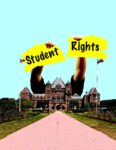WATERLOO, Ont. (CUP) — Stemming from political commentator Rick Mercer’s call to action, 18 “vote mobs” of students encouraging youth to participate in next month’s federal election have sprung up across the country.
Spreading from an original vote mob at the University of Guelph, which took place on March 31, videos of students nation-wide have begun appearing on YouTube, Facebook events have been created to encourage young voters to participate in similar rallies and the organization Leadnow has begun more initiatives to encourage the youth vote.
“What Gracen [Johnson] and Yvonne [Su] started at Guelph has just taken off and it’s something I hope our video is really going to be able to build on,” said Elizabeth Dubois, a student at the University of Ottawa who organized a vote mob that took place April 9.
Not only is the objective of the vote mobs to encourage students to vote, it is also to call attention to issues important to students that some feel are being ignored by politicians.
Organizer of April 14’s vote mob at McGill University Toby Davine said she hopes the event will “show the candidates in the election that we’re voting, that we’re engaged, that we’re a very powerful demographic and we’re trying to spread the word and challenge other universities to do the same.”
The organization Leadnow has undertaken the role of providing a central place to compile videos of the vote mobs and get youth across the country interested in the upcoming election. Leadnow is also incorporating other initiatives such as a “vote wave” where students get together to vote during the advanced polls, being held over the Easter weekend.
“We’re trying to combine the voter socials and the vote mobs into what we’re calling a vote wave of younger folks coming out to vote all across the country,” said Jamie Biggar, the executive director and co-founder of Leadnow. “What we’re hoping will come out of the vote wave is a renewed attention and focus from the political parties on the concerns of younger voters.”
What Biggar and others hope for is a renewed focus on younger voters, which they hope can be achieved through the creation of these vote mobs and vote waves. With six more vote mobs scheduled between now and the end of this month, and certainly more to come, student initiatives are appearing to be far from silent.
“What we’re looking for is a new focus by the parties on the interest of young voters and a way of breaking the vicious cycle of parties not thinking that younger voters are going to come out to the polls,” said Biggar.
For an election period that takes place during what is usually the busiest time in a student’s schedule, concerns have been raised regarding voter turnout among post-secondary students and other youth.
“It was just fantastic to see that many people [at our vote mob] even though you know exams have started, people are writing essays,” said Dubois of the election’s inconvenient timing.
Although this year’s federal election may present some hurdles for students, Davine remains positive regarding the effect the vote mobs and other initiatives will have on the student turnout.
“I think most of what we want to do is inspire the youth to get engaged and to vote and also just to show politicians that they should be targeting us and that we do have a voice,” said Davine.






